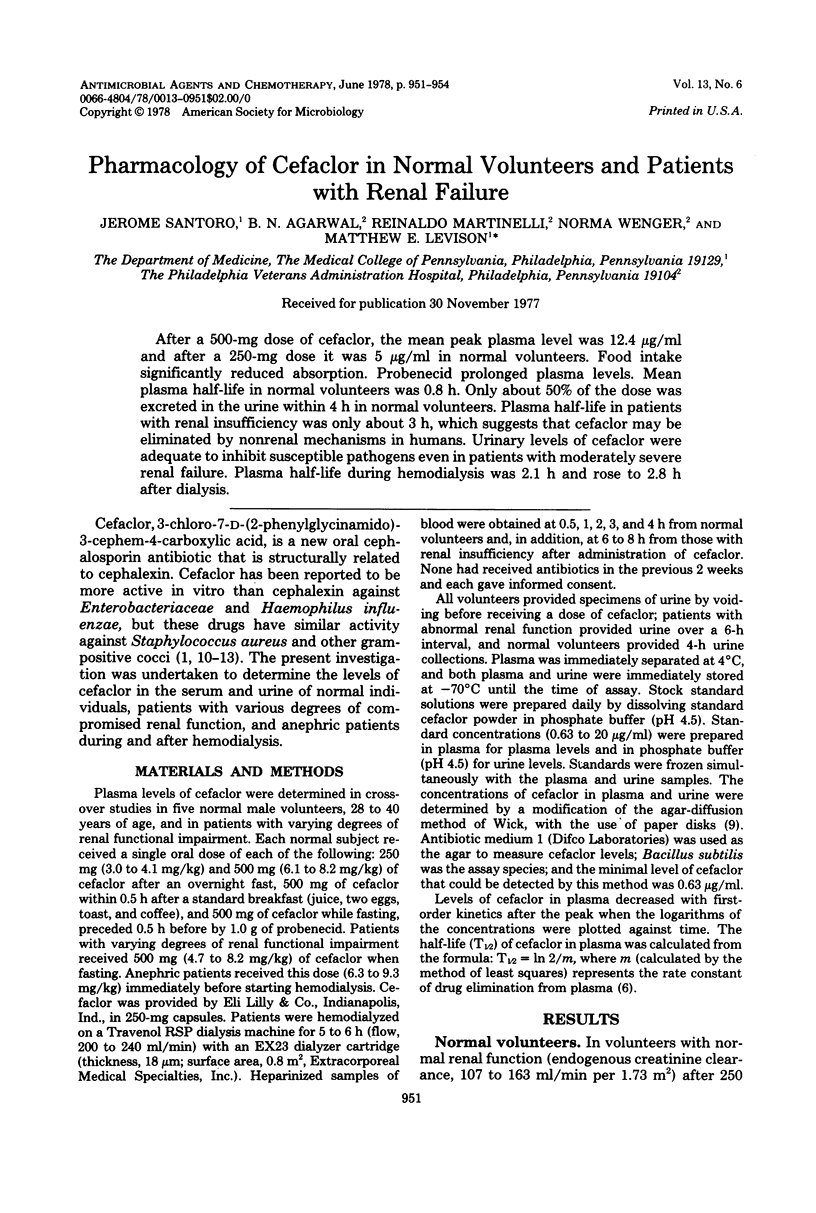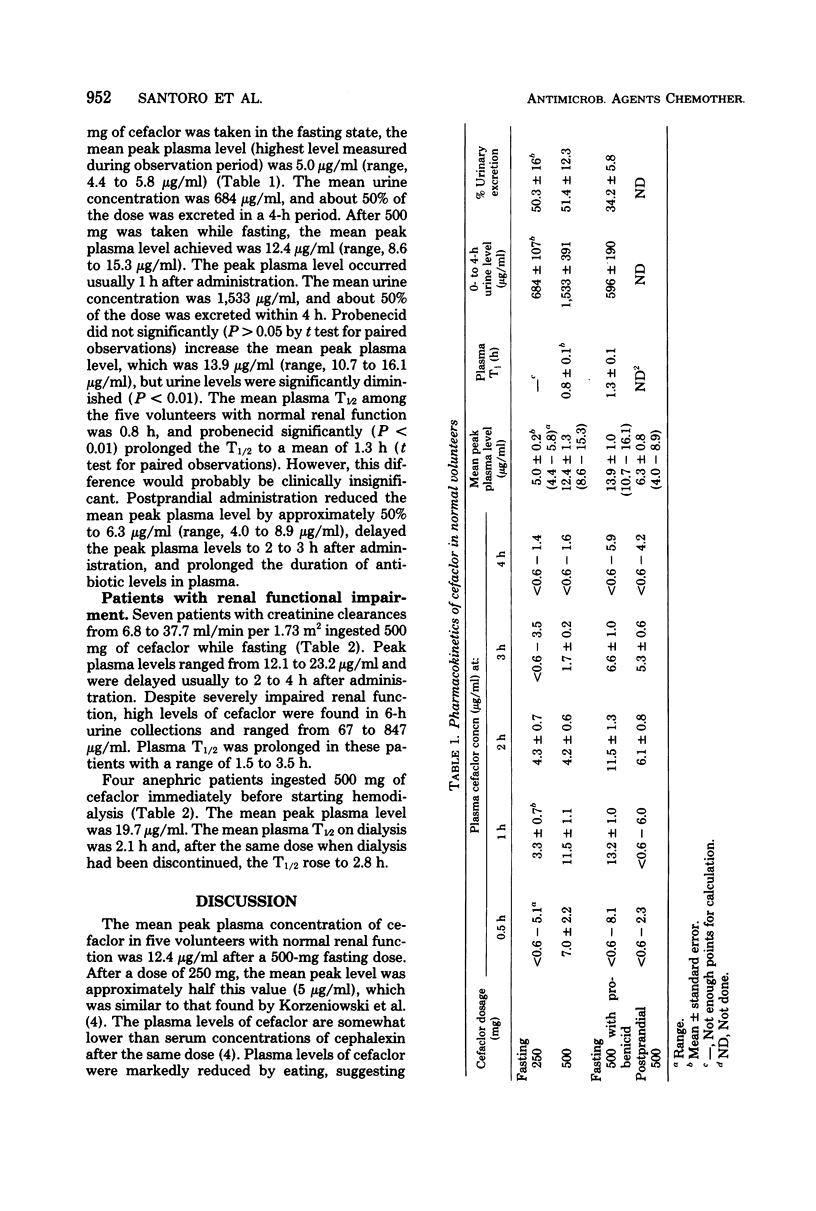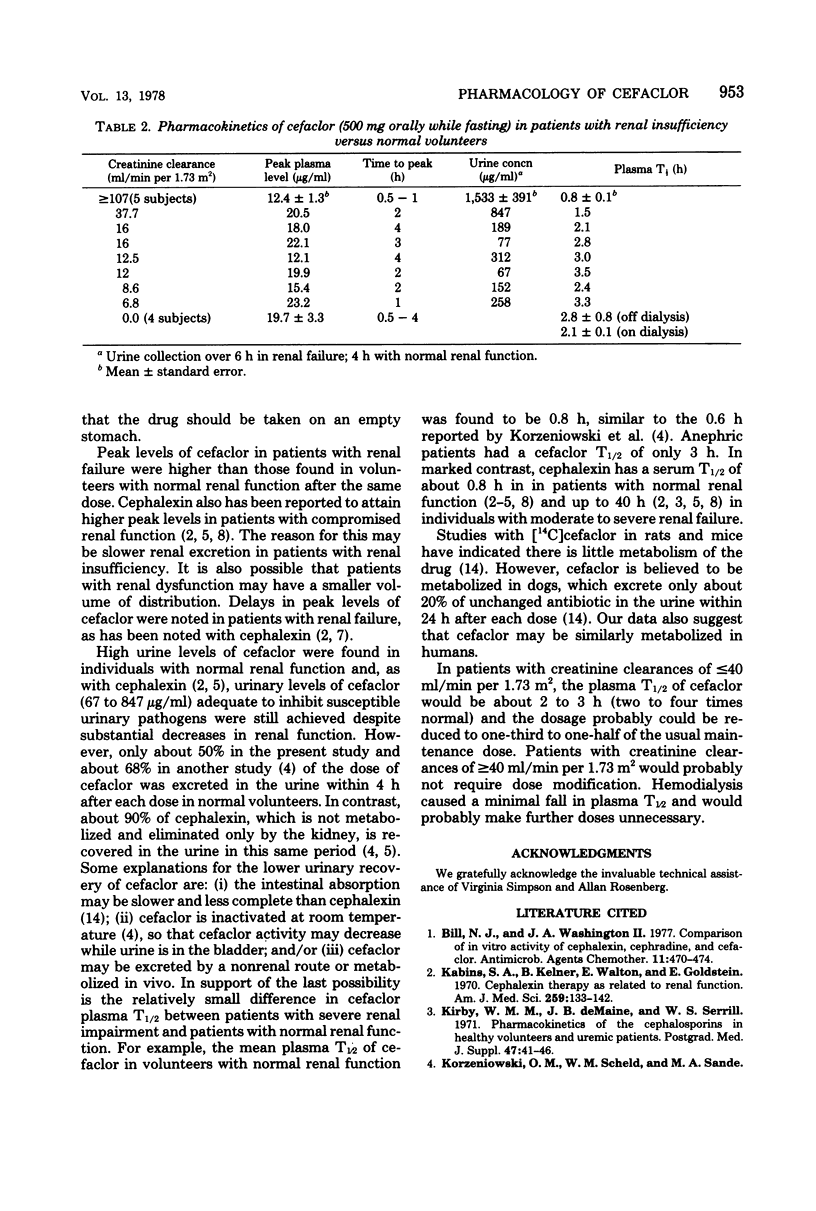Abstract
After a 500-mg dose of cefaclor, the mean peak plasma level was 12.4 μg/ml and after a 250-mg dose it was 5 μg/ml in normal volunteers. Food intake significantly reduced absorption. Probenecid prolonged plasma levels. Mean plasma half-life in normal volunteers was 0.8 h. Only about 50% of the dose was excreted in the urine within 4 h in normal volunteers. Plasma half-life in patients with renal insufficiency was only about 3 h, which suggests that cefaclor may be eliminated by nonrenal mechanisms in humans. Urinary levels of cefaclor were adequate to inhibit susceptible pathogens even in patients with moderately severe renal failure. Plasma half-life during hemodialysis was 2.1 h and rose to 2.8 h after dialysis.
Full text
PDF



Selected References
These references are in PubMed. This may not be the complete list of references from this article.
- Bill N. J., Washington J. A., 2nd Comparison of in vitro activity of cephalexin, cephradine, and cefaclor. Antimicrob Agents Chemother. 1977 Mar;11(3):470–474. doi: 10.1128/aac.11.3.470. [DOI] [PMC free article] [PubMed] [Google Scholar]
- Kabins S. A., Kelner B., Walton E., Goldstein E. Cephalexin therapy as related to renal function. Am J Med Sci. 1970 Feb;259(2):133–142. doi: 10.1097/00000441-197002000-00007. [DOI] [PubMed] [Google Scholar]
- Kirby W. M., De Maine J. B., Serrill W. S. Pharmacokinetics of the cephalosporins in healthy volunteers and uremic patients. Postgrad Med J. 1971 Feb;47(Suppl):41–46. [PubMed] [Google Scholar]
- Korzeniowski O. M., Scheld W. M., Sande M. A. Comparative pharmacology of cefaclor and cephalexin. Antimicrob Agents Chemother. 1977 Aug;12(2):157–162. doi: 10.1128/aac.12.2.157. [DOI] [PMC free article] [PubMed] [Google Scholar]
- Kunin C. M., Finkelberg Z. Oral cephalexin and ampicillin: antimicrobial activity, recovery in urine, and persistence in blood of uremic patients. Ann Intern Med. 1970 Mar;72(3):349–356. doi: 10.7326/0003-4819-72-3-349. [DOI] [PubMed] [Google Scholar]
- Levison M. E., Levison S. P., Ries K., Kaye D. Pharmacology of cefazolin in patients with normal and abnormal renal function. J Infect Dis. 1973 Oct;128(Suppl):S354–S357. doi: 10.1093/infdis/128.supplement_2.s354. [DOI] [PubMed] [Google Scholar]
- Linquist J. A., Siddiqui J. Y., Smith I. M. Cephalexin in patients with renal disease. N Engl J Med. 1970 Oct 1;283(14):720–723. doi: 10.1056/NEJM197010012831402. [DOI] [PubMed] [Google Scholar]
- Regamey C., Humair L. Pharmacokinetics of cephalexin in renal insufficiency. Postgrad Med J. 1971 Feb;47(Suppl):69–78. [PubMed] [Google Scholar]
- Ries K., Levison M. E., Kaye D. Clinical and in vitro evaluation of cefazolin, a new cephalosporin antibiotic. Antimicrob Agents Chemother. 1973 Feb;3(2):168–174. doi: 10.1128/aac.3.2.168. [DOI] [PMC free article] [PubMed] [Google Scholar]
- Santoro J., Levison M. E. In vitro activity of cefaclor, a new orally administered cephalosporin antibiotic. Antimicrob Agents Chemother. 1977 Sep;12(3):442–443. doi: 10.1128/aac.12.3.442. [DOI] [PMC free article] [PubMed] [Google Scholar]
- Scheld W. M., Korzeniowski O. M., Sande M. A. In vitro susceptibility studies with cefaclor and cephalexin. Antimicrob Agents Chemother. 1977 Aug;12(2):290–292. doi: 10.1128/aac.12.2.290. [DOI] [PMC free article] [PubMed] [Google Scholar]
- Shadomy S., Wagner G., Carver M. In vitro activities of five oral cephalosporins against aerobic pathogenic bacteria. Antimicrob Agents Chemother. 1977 Nov;12(5):609–613. doi: 10.1128/aac.12.5.609. [DOI] [PMC free article] [PubMed] [Google Scholar]
- Silver M. S., Counts G. W., Zeleznik D., Turck M. Comparison of in vitro antibacterial activity of three oral cephalosporins: cefaclor, cephalexin, and cephradine. Antimicrob Agents Chemother. 1977 Nov;12(5):591–596. doi: 10.1128/aac.12.5.591. [DOI] [PMC free article] [PubMed] [Google Scholar]
- Sullivan H. R., Due S. L., Kau D. L., Quay J. F., Miller W. Metabolism of (14C) cefaclor, a cephalosporin antibiotic, in three species of laboratory animals. Antimicrob Agents Chemother. 1976 Oct;10(4):630–638. doi: 10.1128/aac.10.4.630. [DOI] [PMC free article] [PubMed] [Google Scholar]


